These are the right bees: mechanical adaptation to dynamic effects
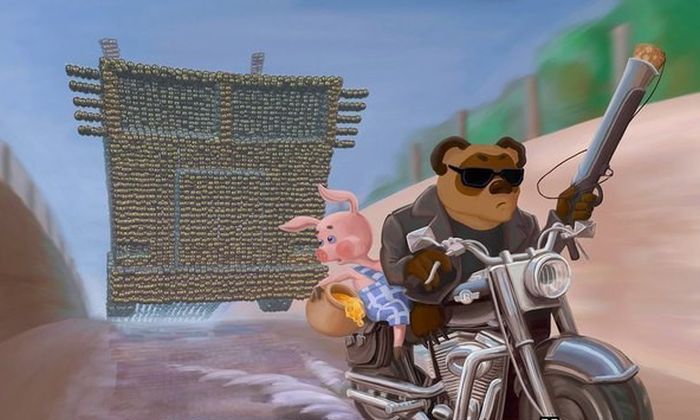
The development of artificial neural networks aims to recreate a kind of artificial brain. All neurons are connected to each other, transmit signals to each other and depend on each other. The more of them, the more complex and development will be the network. Today we will pay attention not to artificial networks, but to those that we can observe in nature, because much in human technology is borrowed precisely from-there. But what can be compared with the human brain or with an artificial neural network? The answer is non-standard - a swarm of bees. Individually, the bees are not as interesting to scientists as in the swarm. We all know how smoothly and effectively the swarm works for the benefit of the hive. Each bee performs a specific task, without interfering with others, but complementing the general mechanism of the hive, which works unceasingly. Today we will understand an unusual study trying to explain how a swarm of bees copes with the dangers of the external environment and how individual individuals interact in such situations. What danger did the scientists present to the poor bee, how did they cope with it and what does this mean for man and science? We will look for answers in the report. Go.
The basis of the study
At first glance, such a study seems a bit silly, because in essence it is the answer to the question “what would happen if you poke a stick at the hive?” Well, firstly, this is not worth doing, as the bees are very touchy creatures (and stinging). Secondly, any living being, like any device, works according to a certain algorithm. In the case of bees, this algorithm is common to the entire swarm. From the point of view of mathematics, programming, and even the mechanics of bees are very interesting. Therefore, let us not inflate our skepticism and allow curiosity to prevail.
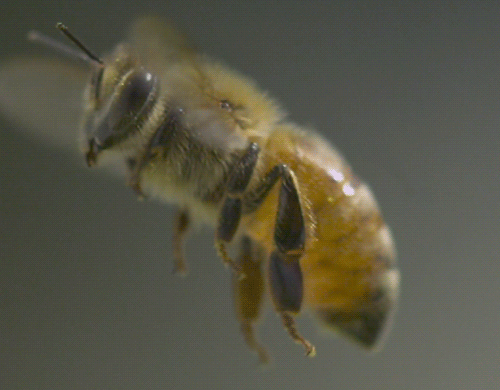
Bee in motion
')
The main heroes of the study were Apis mellifera (or simply “European honey”), which create hives hanging from tree branches and consist mostly of bees themselves. The construction, frankly, is questionable, given the weather changes, natural enemies, etc. However, such hives can survive quite successfully for a long time. The question arises - how? The answer lies in collectivism. Researchers cite as an example some species of ants that join each other, creating rafts to move around the water surface. Such species of living organisms as bees, termites or ants belong to superorganisms, that is, organisms consisting of many organisms. This is comparable with Lego parts: one part does not represent anything, but join them into a cluster and you will get a death star on 3803 parts.
However, in such biological systems, the principle “the more the better” does not work, since overcrowding in adverse conditions can lead to chaos and, as a result, to the death of the entire colony. Honeybees expand their colony literally colonizing neighboring branches of a tree. A group of bees headed by the queen move from the mother hive to a new place where they form the hive satellite, the number of which can reach 10,000 individuals. In the old hive, however, a new queen appears. This once again shows us how coherent the hive is, as a system of many working units.
Let's return to our honey transforming bees. Scientists say that much is known about how they form such unusual hives during the relocation, but little is known about the stability of such “buildings” in relation to the dynamic effects.

Image number 1
Pictures 1a show variations of the shape of a bee cluster (swarm-hive) during swarming (creating a new colony), which usually looks like an inverted cone ( 1b ).
Temperature changes for these bees are not a problem. They regulate the density of the swarm and its area in order to maintain a stable temperature in its center where the queen dwells. If the ambient temperature rises, for example in summer, the swarm expands, forming some grooves that promote air circulation. In case of rain, the bees on the outside of the cluster form a “shield”, due to which the moisture simply flows down.
These abilities of bees are known, but it remains not completely clear how they maintain cluster stability in the event of dynamic impact. The destruction of the cluster can cause the death of almost the entire swarm. This is what scientists will explore.
Preparing for the experiment
For the experiment, a room was prepared, on the board under the ceiling of which the queen queen was placed. The bees were released into the room and began to form a cluster, the process of which is shown in the pictures 1c .
A small motor is attached to the board, capable of moving it horizontally and vertically with different frequency (from 0.5 to 5 Hz) and different acceleration of free fall (from 0 to 0.1 g).

The appearance of the setup for the experiment: A - horizontal movement, B - vertical.

Mechanical impact on the hive: A - continuous cluster shaking, when the frequency is stable, and the acceleration changes; B - intermittent shaking of the cluster, when the acceleration is stable, and the frequency changes; C - single shake.
Turning on the horizontal shaking mode, the cluster starts to swing like a pendulum, with a frequency of approximately 1 Hz. But after a few minutes, the bees adapt to the dynamic mode and change the cluster shape to a flatter one, while the number of individuals remains the same as before the start of the test.
Cluster during horizontal jarring: reshaping
Upon completion of the test, the bees restore the original form of the cluster within 30-120 minutes. It is worth noting that the recovery process takes much longer than the process of forming the "emergency" form.
The analysis of data of continuous and intermittent shaking showed that the reaction to a constant occurs much earlier. With intermittent bees begin to rebuild the cluster only after a few pushes.
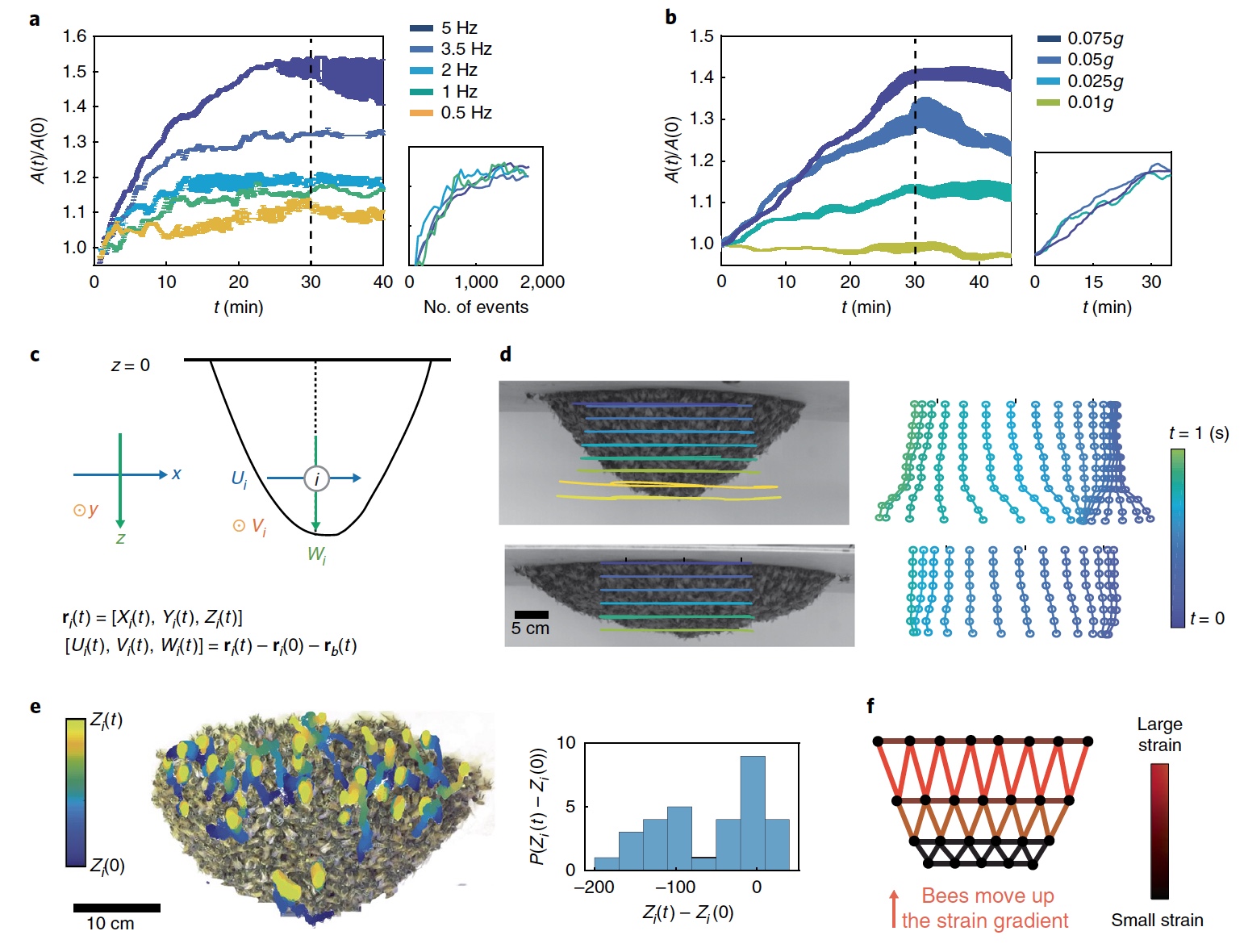
Image number 2
Graph 2a is an indicator of the change in the area of the cluster based on as a function of time (A (t) / A (0), where A (t) is the area after the test, A (0) is before the test). The colors of the lines correspond to different frequencies of periodic shocks.
The adjacent graph ( 2b ) shows changes already with a constant cluster shake. Here we can note that with extremely low acceleration (of the order of 0.01 g), the cluster does not react at all, which suggests that there is a certain threshold of activity. If the dynamics do not reach this threshold, the bees do not perceive it as a danger and do not begin to rebuild the cluster into a more stable form. 2c is the coordinate system of the cluster and individuals.
The researchers calculated a formula that will help mathematically represent the process of movement of each bee during the dynamic impact on the hive. This is necessary to understand the difference in cluster response to constant and intermittent jolts ( 2d ).
After analyzing the trajectories of the bees, the scientists noticed that the relative displacement between the bees at the top of the cluster and the bees at the base is much larger when it is elongated, that is, before the test. The survey confirmed that mechanical adaptation of the swarm allows leveling the local deformations of the cluster (normal deformation and displacement) during the transition to a flat state, that is, during and after the test.
At the moment when shocks occur, the bees begin to move to the base of the hive, which was determined by tracking individuals ( 2e ).
Movement of individuals to the base of the cluster.
This observation confirms the reason for this behavior - the feeling of deformation. More precisely, the bee senses that a gap has appeared between it and the neighboring individual, which should not be. This provokes her to move to the base, in order to strengthen the hive. Why precisely to the base? The cluster of bees can be represented in the form of a scheme (2f), on which the light red areas are the zones with the greatest load, and the dark ones with the smallest. The bees know in which part of the hive the load on its structure is the largest, so you need to move there in order to strengthen this zone.
Having understood the above described principle of behavior of bees, scientists ask a new question - what should be the relative bias for a bee to react?

First of all, the researchers remind that the main dynamic characteristics of a suspended flexible cone are similar to a pendulum when moving from side to side, and when moving up and down with a spring.
The image above shows a cluster model in which each individual bee is represented as a spherical body, which is influenced by three forces: the force of gravity, the force of attraction between neighboring bodies and the force preventing one from penetrating one body into another.
The mathematical model revealed an interesting fact - the maximum amplitude of local loads increases when the cluster becomes elongated. Thus, it is these loads that serve as a signal for the bees.
Demonstration of cluster displacement during computer simulation .
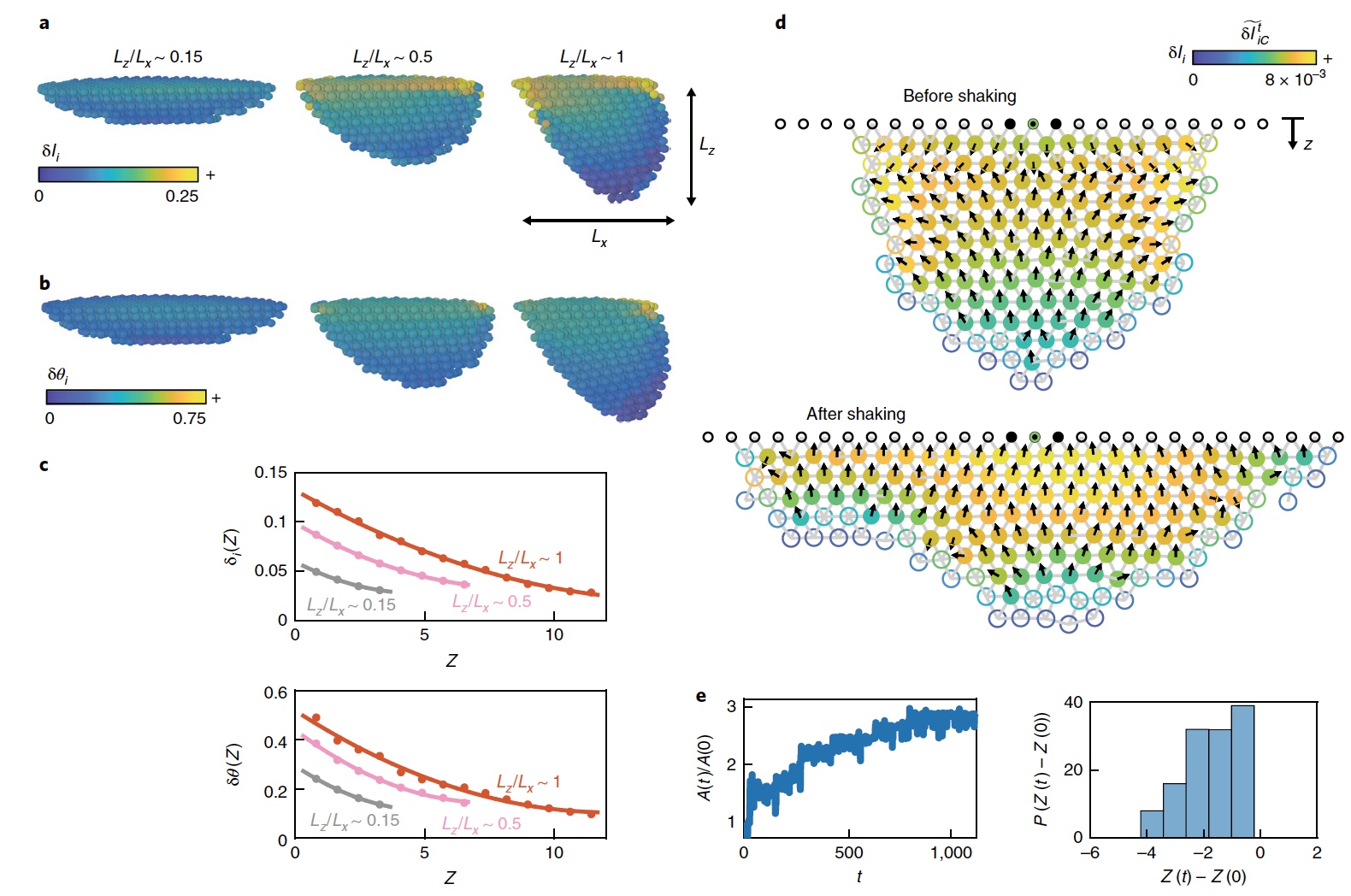
Image number 3: computer model.
As can be seen from simulation 3a , the normal deformation (should be equal to 0) during horizontal oscillations increases exactly at the base. 3b shows shear changes during horizontal oscillation. Here we see that this type of deformation is not so significant. Graph 3c shows the changes in the normal strain and shear in the context of the hive's displacement from the initial position.
Each area in the mathematical computer model is a separate bee, as mentioned earlier. He implemented a behavioral rule - move to areas where the load begins to increase above the critical level. As a result, the model showed that it was possible to observe live with the bees ( 3d ). The plots on the 3rd show how the area of the hive at the base and the proportion of bees that moved towards it changed (corresponds to plot 2e).
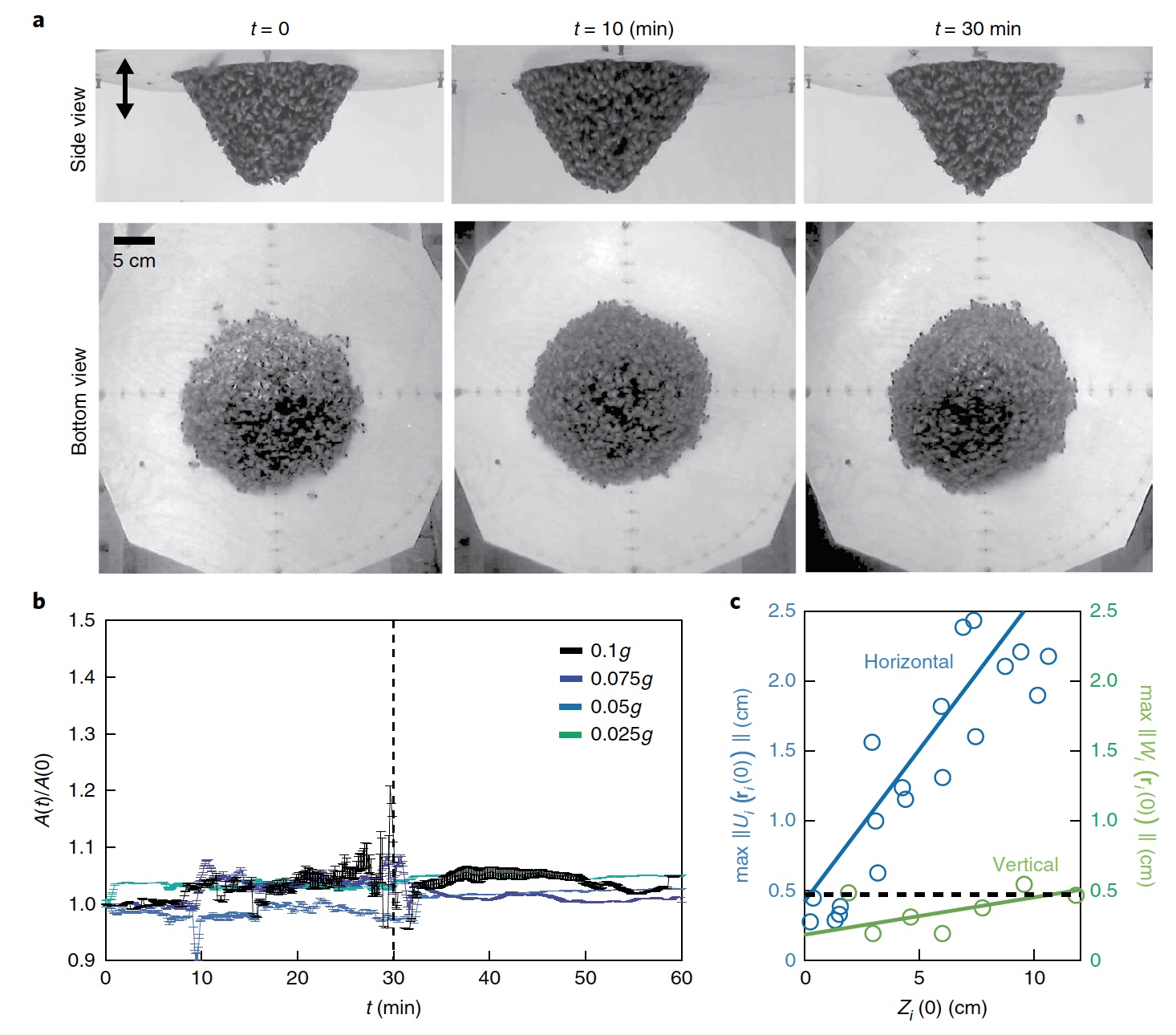
Image number 4: vertical vibrations.
During the experiment with vertical rocking of the hive, the acceleration was no more than 0.05 g. As a result, the observed shifts were very small. This can be seen in the pictures at 4a, where the shape of the hive has not changed for 30 minutes.
However, as the free fall acceleration increased to 0.1 g, the cluster collapsed. The bottom line is that during such fluctuations the load at the base of the hive does not change enough to provoke the bees to move. In the video below it can be seen that the shape of the cluster practically does not change during shaking. And when the critical level of acceleration is reached, the hive simply collapses. One of the factors affecting the bees is the time they did not have enough to react to the already critical level of load on the hive.
Cluster destruction during the test with vertical vibrations.
The findings of researchers
Regardless of the frequency or acceleration of the bees change the shape of the cluster, making it more stable. It looks like a very coordinated work, but the teams from a single source of the bees do not receive, but act completely independently, albeit in the same way. The main engine of their actions is the ability to feel the local deformation of the structure of the hive. When these strains reach a critical level, the bees strengthen the cluster. This is confirmed by the test with constant and intermittent jolts. And the fact that the bees will not react to fluctuations with an acceleration of less than 0.01 g.
If the cluster is shaken vertically, a different situation arises. Bees will not react to deformations, since the load at the base will not exceed the allowable rate.
The researchers, in spite of this, were satisfied with the results of their work. Their work helped to understand the principle of mechanical adaptation. According to them, man-made devices are inferior in this matter to bees. First, the bee, as a separate part of the mechanism (hive), reacts to the threat independently, without requiring commands from the “center”. As a result, all the bees simultaneously begin to rebuild the hive so that it can withstand the destructive influence of external factors. The implementation of such behavior as an algorithm in the systems created by man would greatly simplify the struggle with nature, which quite often shows its character, destroying buildings and equipment.
Details of the study are available in the report of scientists and in additional materials to it.
Epilogue
There is nothing surprising in the search for inspiration or ideas for modern technology in nature. Many inventions in one way or another began with the question “how to repeat what nature is like in insects, fish, birds, etc.”. The path is difficult and long. Once, looking at the sky, a man wanted to fly like a bird, and created wings. True first attempts ended sadly for these enthusiasts. But look what we have now - huge planes carrying hundreds of people across the oceans at a time. But the first one who dreams of flying is also told that his ideas are nonsense. Therefore, even the study of the adaptation of bees to dynamic effects, strange as it may sound, will sooner or later find its practical application in the technologies of the future. Perhaps this study in conjunction with nanotechnology will allow you to create a material that can recombine during earthquakes. Who knows. In any case, healthy curiosity and the desire to understand how the world around you works is great.
Thank you for staying with us. Do you like our articles? Want to see more interesting materials? Support us by placing an order or recommending to friends, 30% discount for Habr users on a unique analogue of the entry-level servers that we invented for you: The whole truth about VPS (KVM) E5-2650 v4 (6 Cores) 10GB DDR4 240GB SSD 1Gbps from $ 20 or how to share the server? (Options are available with RAID1 and RAID10, up to 24 cores and up to 40GB DDR4).
VPS (KVM) E5-2650 v4 (6 Cores) 10GB DDR4 240GB SSD 1Gbps until December for free if you pay for a period of six months, you can order here .
Dell R730xd 2 times cheaper? Only we have 2 x Intel Dodeca-Core Xeon E5-2650v4 128GB DDR4 6x480GB SSD 1Gbps 100 TV from $ 249 in the Netherlands and the USA! Read about How to build an infrastructure building. class c using servers Dell R730xd E5-2650 v4 worth 9000 euros for a penny?
Source: https://habr.com/ru/post/424687/
All Articles